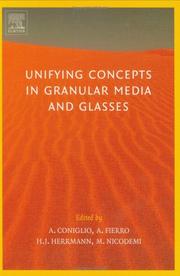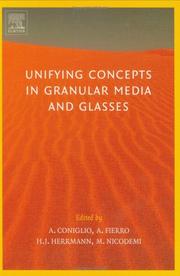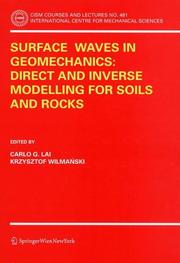| Listing 1 - 6 of 6 |
Sort by
|

ISBN: 9780080474687 0080474683 1280966009 9781280966002 9786610966004 9780444516077 0444516077 Year: 2004 Publisher: Amsterdam Boston Elsevier
Abstract | Keywords | Export | Availability | Bookmark
 Loading...
Loading...Choose an application
- Reference Manager
- EndNote
- RefWorks (Direct export to RefWorks)
Deep connections are emerging in the physics of non-thermal systems,such as granular media, and other ""complex systems"" such as glass formers, spin glasses, colloids or gels. This book discusses the unifying physical theories, developed in recent years, for the description of these systems. The special focus of the book is on recent important developments in the formulation of a Statistical Mechanics approach to granular media and the description of out-of-equilibrium dynamics, such as ""jamming"" phenomena, ubiquitous in these ""complex systems"". The book collects contributions from leadin
Granular materials --- Spin glasses --- Glass --- Granular media --- Glasses
Book
Year: 2017 Publisher: Frontiers Media SA
Abstract | Keywords | Export | Availability | Bookmark
 Loading...
Loading...Choose an application
- Reference Manager
- EndNote
- RefWorks (Direct export to RefWorks)
Fluid flow in transforming porous rocks, fracture networks, and granular media is a very active interdisciplinary research subject in Physics, Earth Sciences, and Engineering. Examples of natural and engineered processes include hydrocarbon recovery, carbon dioxide geo-sequestration, soil drying and wetting, pollution remediation, soil liquefaction, landslides, dynamics of wet or dry granular media, dynamics of faulting or friction, volcanic eruptions, gas venting in sediments, karst development and speleogenesis, ore deposit development, and radioactive waste disposal. Hydrodynamic flow instabilities and pore scale disorder typically result in complex flow patterning. In transforming media, additional mechanisms come into play: compaction, de-compaction, erosion, segregation, and fracturing lead to changes in permeability over time. Dissolution, precipitation, and chemical reactions between solutes and solids may gradually alter the composition and structure of the solid matrix, either creating or destroying permeable paths for fluid flow. A complex, dynamic feedback thus arises where, on the one hand, the fluid flow affects the characteristics of the porous medium, and on the other hand the changing medium influences the fluid flow. This Research Topic Ebook presents current research illustrating the depth and breadth of ongoing work in the field of flow and transformation in porous media through 15 papers by 72 authors from around the world. The body of work highlights the challenges posed by the vast range of length- and time-scales over which subsurface flow processes occur. Importantly, phenomena from each scale contribute to the larger-scale behavior. The flow of oil and gas in reservoirs, and the flow of groundwater on catchment scale is sensitively linked to pore scale processes and material heterogeneity down to the micrometer scale. The geological features of the same reservoirs and catchments evolved over millions of years, sometimes as a consequence of cracking and fracture growth occurring on the time scale of microseconds. The research presented by the authors of this Research Topic represents a step toward bridging the separation of scales as well as the separation of scientific disciplines so that a more unified picture of flow and transformation in porous media can start to emerge.
Porous media --- precipitation --- stress --- rocks --- Friction --- dissolution --- fluid --- transport --- fractures --- granular media --- Porous media --- precipitation --- stress --- rocks --- Friction --- dissolution --- fluid --- transport --- fractures --- granular media
Book
Year: 2017 Publisher: Frontiers Media SA
Abstract | Keywords | Export | Availability | Bookmark
 Loading...
Loading...Choose an application
- Reference Manager
- EndNote
- RefWorks (Direct export to RefWorks)
Fluid flow in transforming porous rocks, fracture networks, and granular media is a very active interdisciplinary research subject in Physics, Earth Sciences, and Engineering. Examples of natural and engineered processes include hydrocarbon recovery, carbon dioxide geo-sequestration, soil drying and wetting, pollution remediation, soil liquefaction, landslides, dynamics of wet or dry granular media, dynamics of faulting or friction, volcanic eruptions, gas venting in sediments, karst development and speleogenesis, ore deposit development, and radioactive waste disposal. Hydrodynamic flow instabilities and pore scale disorder typically result in complex flow patterning. In transforming media, additional mechanisms come into play: compaction, de-compaction, erosion, segregation, and fracturing lead to changes in permeability over time. Dissolution, precipitation, and chemical reactions between solutes and solids may gradually alter the composition and structure of the solid matrix, either creating or destroying permeable paths for fluid flow. A complex, dynamic feedback thus arises where, on the one hand, the fluid flow affects the characteristics of the porous medium, and on the other hand the changing medium influences the fluid flow. This Research Topic Ebook presents current research illustrating the depth and breadth of ongoing work in the field of flow and transformation in porous media through 15 papers by 72 authors from around the world. The body of work highlights the challenges posed by the vast range of length- and time-scales over which subsurface flow processes occur. Importantly, phenomena from each scale contribute to the larger-scale behavior. The flow of oil and gas in reservoirs, and the flow of groundwater on catchment scale is sensitively linked to pore scale processes and material heterogeneity down to the micrometer scale. The geological features of the same reservoirs and catchments evolved over millions of years, sometimes as a consequence of cracking and fracture growth occurring on the time scale of microseconds. The research presented by the authors of this Research Topic represents a step toward bridging the separation of scales as well as the separation of scientific disciplines so that a more unified picture of flow and transformation in porous media can start to emerge.
Porous media --- precipitation --- stress --- rocks --- Friction --- dissolution --- fluid --- transport --- fractures --- granular media
Book
Year: 2017 Publisher: Frontiers Media SA
Abstract | Keywords | Export | Availability | Bookmark
 Loading...
Loading...Choose an application
- Reference Manager
- EndNote
- RefWorks (Direct export to RefWorks)
Fluid flow in transforming porous rocks, fracture networks, and granular media is a very active interdisciplinary research subject in Physics, Earth Sciences, and Engineering. Examples of natural and engineered processes include hydrocarbon recovery, carbon dioxide geo-sequestration, soil drying and wetting, pollution remediation, soil liquefaction, landslides, dynamics of wet or dry granular media, dynamics of faulting or friction, volcanic eruptions, gas venting in sediments, karst development and speleogenesis, ore deposit development, and radioactive waste disposal. Hydrodynamic flow instabilities and pore scale disorder typically result in complex flow patterning. In transforming media, additional mechanisms come into play: compaction, de-compaction, erosion, segregation, and fracturing lead to changes in permeability over time. Dissolution, precipitation, and chemical reactions between solutes and solids may gradually alter the composition and structure of the solid matrix, either creating or destroying permeable paths for fluid flow. A complex, dynamic feedback thus arises where, on the one hand, the fluid flow affects the characteristics of the porous medium, and on the other hand the changing medium influences the fluid flow. This Research Topic Ebook presents current research illustrating the depth and breadth of ongoing work in the field of flow and transformation in porous media through 15 papers by 72 authors from around the world. The body of work highlights the challenges posed by the vast range of length- and time-scales over which subsurface flow processes occur. Importantly, phenomena from each scale contribute to the larger-scale behavior. The flow of oil and gas in reservoirs, and the flow of groundwater on catchment scale is sensitively linked to pore scale processes and material heterogeneity down to the micrometer scale. The geological features of the same reservoirs and catchments evolved over millions of years, sometimes as a consequence of cracking and fracture growth occurring on the time scale of microseconds. The research presented by the authors of this Research Topic represents a step toward bridging the separation of scales as well as the separation of scientific disciplines so that a more unified picture of flow and transformation in porous media can start to emerge.
Porous media --- precipitation --- stress --- rocks --- Friction --- dissolution --- fluid --- transport --- fractures --- granular media

ISBN: 1280966009 9786610966004 0080474683 0444516077 9780080474687 9781280966002 9780444516077 Year: 2004 Publisher: Amsterdam Boston Elsevier
Abstract | Keywords | Export | Availability | Bookmark
 Loading...
Loading...Choose an application
- Reference Manager
- EndNote
- RefWorks (Direct export to RefWorks)
Deep connections are emerging in the physics of non-thermal systems,such as granular media, and other ""complex systems"" such as glass formers, spin glasses, colloids or gels. This book discusses the unifying physical theories, developed in recent years, for the description of these systems. The special focus of the book is on recent important developments in the formulation of a Statistical Mechanics approach to granular media and the description of out-of-equilibrium dynamics, such as ""jamming"" phenomena, ubiquitous in these ""complex systems"". The book collects contributions from leadin
Glass - Congresses. --- Granular materials - Congresses. --- Granular materials--Congresses. Spin glasses--Congresses. Glass--Congresses. --- Spin glasses - Congresses. --- Granular materials --- Spin glasses --- Glass --- Materials Science --- Chemical & Materials Engineering --- Engineering & Applied Sciences --- Granular media --- Glasses --- Glasses, Magnetic --- Glasses, Spin --- Magnetic glasses --- Magnetic alloys --- Nuclear spin --- Solid state physics --- Bulk solids --- Materials

ISBN: 9783211380659 3211277404 9783211277409 3211380655 Year: 2005 Publisher: Vienna : Springer Vienna : Imprint: Springer,
Abstract | Keywords | Export | Availability | Bookmark
 Loading...
Loading...Choose an application
- Reference Manager
- EndNote
- RefWorks (Direct export to RefWorks)
Theories of surface waves develop since the end of XIX century and many fundamental problems like existence, phase and group velocities, attenuation (quality factor), mode conversion, etc. have been, in part successfully, solved within the framework of such simple models as ideal fluids^ or linear elasticity. However, a sufficiently complete presentation of this subject, particularly for solids, is still missing in the literature. The sole exception is the book of I. A. Viktorov^ which contains an extensive discussion of fundamental properties of surface waves in homogeneous and stratified linear elastic solids with particular emphasis on contributions of Russian scientists. Unfortunately, the book has never been translated to English and its Russian version is also hardly available. Practical applications of surface waves develop intensively since a much shorter period of time than theories even though the motivation of discoverers of surface waves such as Lord Rayleigh stems from their appearance in geophysics and seismology. Nowadays the growing interest in practical applications of surface waves stem from the following two main factors: surface waves are ideal for developing relatively cheap and convenient methods of nondestructive testing of various systems spanning from nanomaterials (e.g.
Engineering. --- Continuum Mechanics and Mechanics of Materials. --- Applied Geosciences. --- Mechanics. --- Granular Media. --- Acoustics. --- Software Engineering. --- Software engineering. --- Physics. --- Materials. --- Ingénierie --- Génie logiciel --- Mécanique --- Physique --- Acoustique --- Matériaux --- Rayleigh waves. --- Rock mechanics. --- Soil mechanics. --- Surface waves. --- Engineering & Applied Sciences --- Chemical & Materials Engineering --- Applied Mathematics --- Materials Science --- Soil engineering --- Soils --- Soils (Engineering) --- Mechanics --- Geotechnical engineering. --- Amorphous substances. --- Complex fluids. --- Continuum mechanics. --- Geotechnical Engineering & Applied Earth Sciences. --- Soft and Granular Matter, Complex Fluids and Microfluidics. --- Geotechnical engineering --- Acoustic surface waves --- Elastic waves --- Fluid dynamics --- Geodynamics --- Seismic waves --- Foundations --- Soil physics --- Surface waves (Oceanography) --- Gravity waves --- Surface energy --- Mechanics, Applied. --- Solid Mechanics. --- Classical Mechanics. --- Computer software engineering --- Engineering --- Applied mechanics --- Engineering, Mechanical --- Engineering mathematics --- Classical mechanics --- Newtonian mechanics --- Physics --- Dynamics --- Quantum theory --- Complex liquids --- Fluids, Complex --- Amorphous substances --- Liquids --- Soft condensed matter --- Engineering, Geotechnical --- Geotechnics --- Geotechnology --- Engineering geology
| Listing 1 - 6 of 6 |
Sort by
|

 Search
Search Feedback
Feedback About UniCat
About UniCat  Help
Help News
News